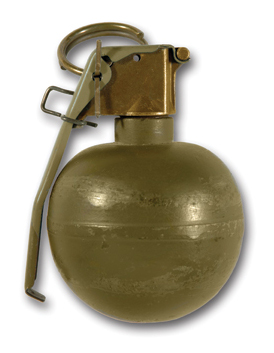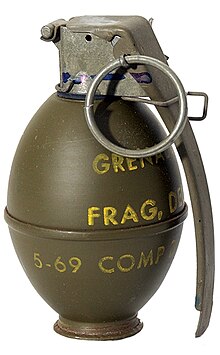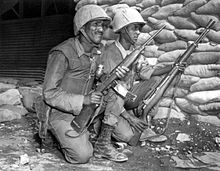
A booby trap is a device or setup that is intended to kill, harm or surprise a human or another animal. It is triggered by the presence or actions of the victim and sometimes has some form of bait designed to lure the victim towards it. The trap may be set to act upon trespassers that enter restricted areas, and it can be triggered when the victim performs an action. It can also be triggered by vehicles driving along a road, as in the case of improvised explosive devices (IEDs).

A smoke grenade is a canister-type grenade used as a signaling device, target or landing zone marking device, or as a screening device for unit movements.

"Mills bomb" is the popular name for a series of British hand grenades which were designed by William Mills. They were the first modern fragmentation grenades used by the British Army and saw widespread use in the First and Second World Wars.

The MIM-72A/M48 Chaparral is an American-made self-propelled surface-to-air missile system based on the AIM-9 Sidewinder air-to-air missile system. The launcher is based on the M113 family of vehicles. It entered service with the United States Army in 1969 and was phased out between 1990 and 1998. It was intended to be used along with the M163 VADS, the Vulcan ADS covering short-range short-time engagements, and the Chaparral for longer range use.

The M67 grenade is a fragmentation hand grenade used by the United States military. The M67 is a further development of the M33 grenade, itself a replacement for the M26-series grenades used during the Korean and Vietnam Wars, and the older Mk 2 "pineapple" grenade used since World War I.

The Mk 2 grenade, also nicknamed the Pineapple is a fragmentation-type anti-personnel hand grenade introduced by the U.S. armed forces in 1918. It was the standard issue anti-personnel grenade used during World War II, and also saw limited service in later conflicts, including the Korean War and Vietnam War. Replacing the failed Mk 1 grenade of 1917, it was standardized in 1920 as the Mk II, and redesignated the Mk 2 on April 2, 1945.
The military of the United States has used many different types of hand grenades since its foundation.

The MK3 hand grenade is a cylindrical concussion grenade designed to produce casualties during close combat while minimizing danger to friendly personnel exposed in the open owing to minimal fragmentation. There is a secondary fragmentation hazard though from rocks, gravel, wood splinters, glass, etc. The grenade is also used for concussion effects in enclosed areas, for blasting, or for demolition tasks. The shock waves (overpressure) produced by this grenade when used in enclosed areas are greater than those produced by the fragmentation grenade. It is, therefore, very effective used in an offensive role against enemy soldiers located in bunkers, buildings, and fortified areas. It is commonly known as the "concussion" or "demo" grenade.

The Cambodian Civil War was a military conflict that pitted the guerrilla forces of the Maoist-oriented Communist Party of Kampuchea and the armed and security forces of the Nonaligned Kingdom of Cambodia from 1967 to 1970, then between the joint Monarchist, Maoist and Marxist-Leninist National United Front of Kampuchea alliance and the pro-western Khmer Republic from 1970 to 1975. Main combatants comprised:

The HG 85 is a round fragmentation hand grenade designed for the Swiss Armed Forces, and is still produced by RUAG Ammotec in Switzerland. HG 85 is the internal designation of the Swiss Army and replaced the HG 43 from World War II.

The F1 grenade is manufactured by Thales Australia exclusively for the Australian Defence Force as a primary defensive anti-personnel hand grenade.
In military munitions, a fuze is the part of the device that initiates function. In some applications, such as torpedoes, a fuze may be identified by function as the exploder. The relative complexity of even the earliest fuze designs can be seen in cutaway diagrams.

A grenade is an explosive weapon typically thrown by hand, but can also refer to a shell shot from the muzzle of a rifle or a grenade launcher. A modern hand grenade generally consists of an explosive charge ("filler"), a detonator mechanism, an internal striker to trigger the detonator, an arming safety secured by a transport safety. The user removes the transport safety before throwing, and once the grenade leaves the hand the arming safety gets released, allowing the striker to trigger a primer that ignites a fuze, which burns down to the detonator and explodes the main charge.

The Mk 1 grenade is a fragmentation hand grenade used by American forces during World War I. According to its designers, it was to be the "simplest", yet most "fool-proof", grenade ever made. However, some major problems appeared when the grenade was used in the field. It was retired from service before the war ended, replaced in 1918 with the improved Mk 2 grenade used through World War II.

The M17 is a rifle grenade that was used by the United States during World War II.
The Frangible Grenade M1 was a specially designed factory produced molotov cocktail created by the United States in 1942 as it entered World War II (1939–1945). It was designed to provide lightly armed personnel with simple, uncomplicated weapons that were easy to mass-produce. It provided a cheap stopgap means of knocking out enemy vehicles, clearing out strongpoints, and harassing or killing enemy personnel until more effective weapons could be produced and distributed. It was dubbed "frangible" because it was made from glass, which is brittle and easily broken.

The M1 grenade projection adapter was an expedient rifle grenade used by the American military in World War II, Korea, and Vietnam. It consisted of an add-on 22 mm (0.87 in) stabilizer tube and fins that converted a hand-grenade into a rifle grenade. It supplanted the M17 rifle grenade, and was eventually made obsolete by the 40 mm M79 grenade launcher.
The SFG 87 is a defensive fragmentation hand grenade created in Singapore. It is one of the grenades used for infantry divisions of the Singapore Armed Forces. The grenades are produced mainly by Singaporean weapons manufacturer ST Kinetics. It has been mass-produced since 1987, replacing the older SFG 82 and SFG 75 variants.


















